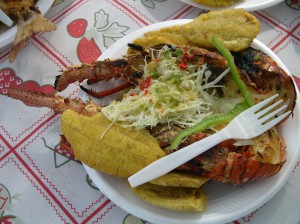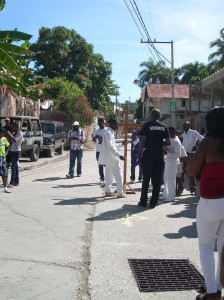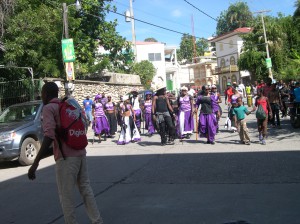Part II Monday November 11, 2014
Yesterday I took the day off, and went with two other American aid workers and Pastor Caleb and his fiancé to the family beach.
At 1 we three women climbed into the back of Pastor Caleb’s old blue truck and 30 minutes later we were at the family beach. The shoreline meandered around in a slow bend moving back to the western mountains.
This beach is a family place with lots of tables and chairs set back from the sand line. The palm trees provide the shade. The tables had those plastic fruit and vegetable coverings with common white plastic chairs.
First thing we did was order drinks. Linda said that we must have a real coconut for the milk and the meet. Then, I had an idea. I wanted to put some Haitian rum, I had heard so much about, into the raw coconut milk. After drinking some and adding a little rum, a young boy of about 9 was asked to split the coconut. When he did, he chipped skillfully with a 12” machete type knife. He cut a small piece off the bottom and then hacked the coconut in 2. The small chip was used to scrape off the top lining inside the coconut, and then wedge the ship into the sides of the raw coconut which lines the think shell.
Then, there’s looking at the ground and the shoreline. Trash. Stamped into the sand all around. Bottle caps, broken glass pieces, coconut pieces, plastic bottles. Then along the shoreline where the sea meets the sand, there was an old red backpack wedged into the sand with every incoming wave. Next to it was a plaid shirt half buried in the sand, while each wave washed over it. Along the shore, the sand is a combination of famous Caribbean white sand and black sand. The ocean up close has more of a green color than the Caribbean blue— except as you look out into the distance.
We ordered lobster or fish dinners, ate them, and sat for a while in companionable silence. When we were all done, several young boys came around, and Pastor Caleb handed them the unfinished plate of rice and beans, plantains that we had not finished. Almost everything in Haiti is hungry. These people eek out an existence just like the dogs, cats, ants and cats that roam around making hungry food business.
Then, we left this scene to run into the endless serf. I haven’t enjoyed myself so much in I don’t know how long. I jumped and screamed with each big wave carrying me forward with the surf only to immediately laugh at the water swirling around me. Dondi and Deb joined me in the serf to all play in the coming tidal waves until we were so tired– it was time to leave.
Fathers and sons were digging a hole in the sand, then placed their feet in it and waited for the waves to wash the sand around the hole. Another man sat spread-ledged facing the short so that the incoming tide washed against his back.
Others were farther out from the shore waiting and playing the waves as they washed ashore. I found such joy and delight in this—jumping into the waves and laughing.
We left soon after that— back to the truck.
There’s another aspect of this afternoon that in some ways made it not so pleasant. When we sat down, there were three Caucasian women and three Haitians—one woman, Pastor Caleb’s fiancé and our driver. We hardly had sat down, and we were greeted with individuals selling carved wooden art, bits of candy and small bags of some kind of nut, goat shish-ka-bobs, and conch shells both small and large. They came around all afternoon, and we kept having to say no, no thank you, no merci, no thank you, no merci. Until we left…
In the truck Pastor Caleb had to visit a few people, and Dondi has bought a piece of art from an older man who told her he was hungry and wanted to sell something. She bought a piece, and as we sat in the back of the truck more people, mostly children, tried to sell us something—when we said no. One at a time said he was hungry and kept saying” one dollar. I’m hungry.”
We left, and I though about that scene all the way home. The dogs running around the place—one dog was pooping and then all of sudden ran off holding up a paw and crying. I don’t know what happened.
I just sat quietly in the truck on the way home—













